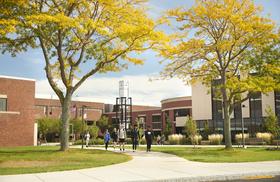After twelve or more years of traditional education, high school seniors look forward to enjoying the “college experience.” Living on campus, freedom to choose classes, and taking advantage of a wide range of extracurricular activities is what makes college such an exciting time in life. Many students choose their school as much for the program as for the on-campus experience.
Since March 7th when The University of Washington became the first large U.S. university to close due to coronavirus, many others have followed suit. According to CNBC, over 1,100 colleges and universities in the United States have closed their campuses, impacting an estimated 14 million students.
In this time of uncertainty, current college students are forced to wonder how these changes will impact the remainder of their college career and, for many, their graduation and entry into the workforce. For prospective students and parents, it raises questions about what a college education will look like in the fall of 2020 and how much it will cost.
In this article, we’ll explore the ways the coronavirus pandemic has affected United States higher education and how students, parents, and the schools themselves are reacting.
How COVID-19 Has Changed the College Experience
In the wake of the COVID-19 crisis, public schools in most states have been closed for weeks already and many have decided not to reopen this school year. College students were asked not to return from spring break or sent home if they were still on campus. Classes have transitioned to remote learning as educators at all levels struggle to finish the remainder of the school year with some sense of normalcy.
Though news of the coronavirus’ severity has been spreading since the end of 2019, its reality in the United States came to a head in early March. What began with voluntary and proactive adjustments to operations turned into statewide policy strictly enforced within a matter of weeks. Students were forced to leave campus with little notice and educators were forced to alter their curriculum for remote learning while simultaneously learning an entirely new educational platform.
The United States finds itself in a nearly unprecedented situation. Though colleges and universities are doing their best to finish out the school year, lack of preparation and resources makes it challenging. Access to technology and reliable service makes it difficult for professors to put quality content online and student access to these services varies. School libraries are heavily affected.
Faculty have transitioned to remote learning, but other school staff struggle to take their jobs online. Library employees are encouraged to work remotely when possible, but a survey conducted by Primary Research Group suggests that community colleges and smaller institutions are struggling with remote work arrangements more than larger institutions. Only 35% of employees at community colleges are working remotely, compared to 75% at research universities.
The state of current events has brought to the surface a number of inequalities within the educational system. The unequal distribution of academic resources and school funding has long been an issue within the public school system, but the current crisis puts these issues on a new stage and college students across the country are speaking out.
The Argument for Tuition Refunds
An article published on Market Watch in the early days of the pandemic’s spread in the United States shows the impact of these changes on college students. Shannon Tremblay, 24, said, “It is upsetting that we are going online but I understand why my college is taking precautions and I respect their decision for trying to keep everyone safe.” As a student in the dental hygiene program, the switch to online classes will impair her ability to receive hands-on instruction and many students are in the same boat.
In fact, students at Miami and Drexel universities have filed a class action lawsuit against their institutions seeking tuition reimbursement.
According to Inside Higher Ed, “It’s a significant development in the tensions over how much students who had been studying on campuses should pay for a semester suddenly upended by social distancing and classes shifting to online or remote instruction.”
Students filing the lawsuit allege breach of contract and unjust enrichment, seeking unspecified damages, fees, and costs. They argue that their universities prevented students from receiving the benefits of in-person education by closing campuses. Though these institutions are still offering some level of academic instruction via online classes, the students allege they are still being deprived of certain benefits. On-campus experiences and services like computer labs, libraries, and networking opportunities have also been affected by these closures.
Some students have even claimed that, “The value of any degree issued on the basis of online or pass/fail classes will be diminished.”
How Are Colleges Responding?
The cost of college tuition has skyrocketed over the past few decades, so it’s difficult to say these students don’t have a valid argument. According to statistics cited by U.S. News, the average cost for in-state tuition in fees at a public for the 2019-20 school year was $10,116. Costs for out-of-state tuition at a public university were $22,577 and, for a private school, $36,801. Community college tuition averages $4,816 per year for in-state students and $8,581 for out-of-state students.
These costs are significant and as many as 85% of college students rely on financial aid to pay them. Fortunately, the federal government stopped student loan payments on March 13, 2020 and will continue to provide relief though September 30, 2020. During this time, certain types of loans will be set at 0% interest and any payments made will be put toward principle.
Relief from student loan interest is certainly a benefit, but the loans were taken out with certain expectations and the education these students are receiving for their tuition has changed. Unfortunately, it seems unlikely that students will be receiving tuition refunds on a large scale.
Schools like Penn State have issued statements like the following,
“Even during this unprecedented national and global challenge, our outstanding faculty are meeting the course and program learning objectives for our students by continuing to deliver a world-class Penn State education… Unfortunately, we believe the cost of fulfilling our educational commitment in a remote setting is likely higher, and there are no plans to issue tuition refunds. Lab experiments are being video streamed, technical, research and operational infrastructures needs are being met, training and technology solutions are being delivered on an unprecedented scale, and more. The University is delivering on our educational promise to our students and will continue to do so.”
The fact is that many schools simply can’t afford to issue refunds for tuition and fees that go toward paying staff salaries. Many schools are, however, issuing partial refunds for room and board.
Harvard University, Smith College, and Amherst College were among the first schools to announce prorated room and board refunds for students. In the weeks since, many other schools have announced partial refund plans, but the details are still in the works for many. The University of Minnesota Board of Regents originally proposed a plan that would cost the university system $12.6 in lost revenue but Minnesota governor Tim Walz’s stay-at-home declaration made on March 25th resulted in a new plan that more than doubled the original figure.
Many community colleges and traditional universities find themselves in the awkward position of trying to refund students while paying existing vendor contracts and compensating their own staff.
What Does It Mean for the Future?
Graduating seniors at community colleges as well as traditional colleges and universities have had to cut their final year short. Not only have they had to say goodbye to friends earlier than anticipated, but many have been forced to find temporary housing. For many, the primary concern is graduating and entering the job market during a recession.
Cheryn Shin, senior at Wellesley College studying English and creative writing, comments, “It feels like even fewer companies are looking to hire… I was told that majoring in the humanities was all about luck and timing… it feels like I have neither of those.”
While graduating college seniors are certainly being put in a difficult situation, graduating high school seniors are being forced to question their plans as well. Some surveys indicate that a higher percentage of students plan to enroll at a community college or part-time in a bachelor’s degree program instead of pursuing their original plans. Others plan to take a gap year. International student enrollment is expected to decline, and even standardized testing may change in the coming years.
The current situation is far from easy but for many, a disruption to an already established life is less challenging than a life that has yet to begin. Graduating seniors and incoming college students need to stay apprised of developments and consider their options for the future carefully.















